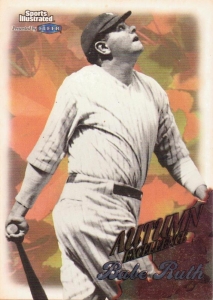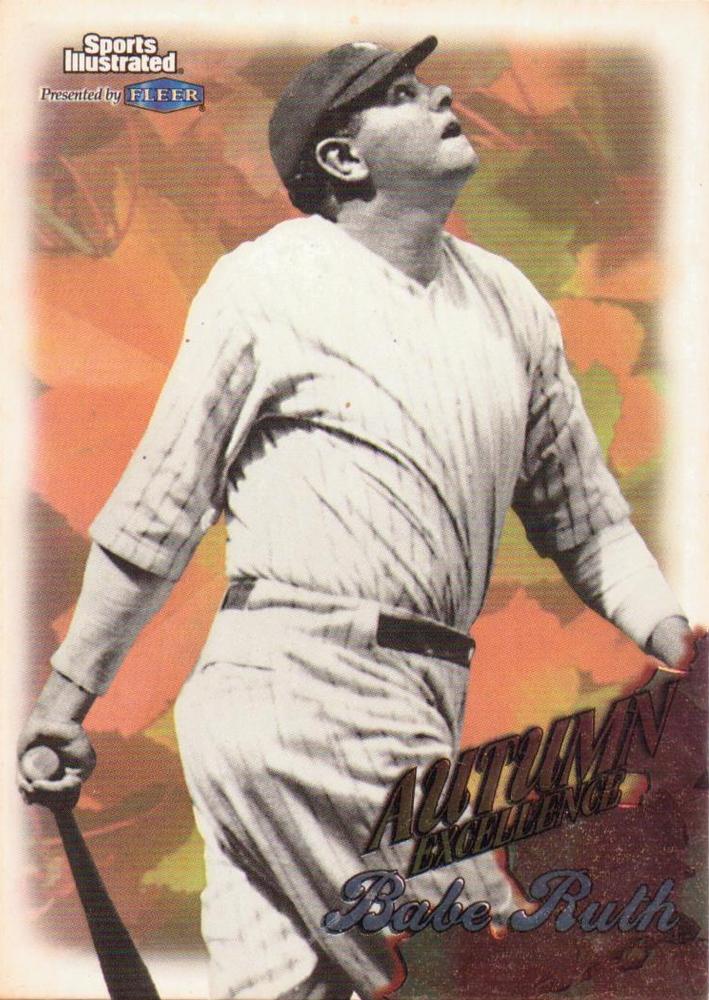September 15, 1921: Babe Ruth again breaks his own home run record with #55 at Polo Grounds
 It came on a full count. A fastball a little bit up in the zone, right in his wheelhouse. From the instant it left the bat there was no doubt that it was bound for the right-field stands. The only question was whether it would end up in the bleachers or in the upper deck. It landed in the upper deck. A towering rainbow shot. Not his longest, but easily long enough. As he trotted around the bases The Babe had a satisfied smile on his face.1 He had once again done what many said he could not do. He had hit his 55th home run of the season. He broke the record that he had set the previous season. It was the third year in a row that he had rewritten the home-run record book.
It came on a full count. A fastball a little bit up in the zone, right in his wheelhouse. From the instant it left the bat there was no doubt that it was bound for the right-field stands. The only question was whether it would end up in the bleachers or in the upper deck. It landed in the upper deck. A towering rainbow shot. Not his longest, but easily long enough. As he trotted around the bases The Babe had a satisfied smile on his face.1 He had once again done what many said he could not do. He had hit his 55th home run of the season. He broke the record that he had set the previous season. It was the third year in a row that he had rewritten the home-run record book.
The blast came at an opportune time for the Yankees. Through four innings, they were down a run to the St. Louis Browns. Until the third inning the only New York hit was a first-inning leadoff single by center fielder Elmer Miller. After walking the next hitter, Roger Peckinpaugh, Browns pitcher Bill Bayne set down the next six Yankees he faced. Carl Mays did even better, retiring all six St. Louis hitters who came to the plate.
That all changed in the third. Wally Gerber, the Browns shortstop, led off with a single and was sacrificed to second. Pitcher Bayne walked and Jack Tobin smacked a double to left, driving in the game’s first run. Bayne scored the second run when Frank Ellerbe grounded out to first. Another run scored on George Sisler’s single to right. The St. Louis star first baseman then stole second, went to third on an error by Yankees catcher Wally Schang, and scored the Browns’ fourth run on a single by Ken Williams.
Down by four, the Yankees immediately mounted an assault of their own. Atoning a bit for his costly error, Schang opened with a single. Pitcher Mays, one of the best hitting pitchers in the American League, shot one to center. Miller laid down a run-scoring bunt single to keep the rally alive. Bayne then struck out Peckinpaugh and got Ruth on a popout to shortstop. However, the three-run lead disappeared instantly when Bob Meusel launched one into the left-field stands.
The Browns regained the lead in the fourth. Second baseman Marty McManus hit a two-out double that scored the Browns’ hulking center fielder, Bill “Baby Doll” Jacobson, who had led off with a single. This time the Yankees were unable to match the Browns’ run.
The Browns went in order in the fifth, setting the stage for Ruth’s record-breaking blast. Miller led off the Yankees’ half of the inning with his third hit of the game, a double. Peckinpaugh flied to right, bringing Ruth to the plate. Bayne had “reveled in a chuckle” after punching Ruth out on three swinging strikes in the first.2 The Browns pitcher added a bit of insult to injury in the third. He “had taken the dangerous liberty of laughing at the Babe” after Ruth popped to shortstop.3 In the fifth, as he so often did, “Babe the Ruthless” had the last laugh.4
Even before the ball landed, hats began raining down on the field. The “hurricane of straw hats” continued as Ruth circled the bases.5 Old battered straw hats mixed with brand-new ones swirling down onto the field. The Babe took his time trotting around the bases. It had been six anxious days since he had hit number 54 and he wanted to savor the moment. Waiting at home plate was the diminutive Yankee mascot, Eddie Bennett. As soon as Ruth stepped on the plate, little Eddie leaped up on to his back and there he stayed as the Babe walked into the dugout.
Ruth’s race to a new home-run record began even before the season started. “You can tell the world I’ll smash out more than 54 homers this year. … That’s what the fans want and the Babe isn’t going to disappoint them.”6 Baseball fans everywhere followed the journey and eagerly awaited the record-breaker. To keep them updated the New York Daily News included a “How Babe Ruth Batted Yesterday” column.
The “Batterin’ Bambino” began his assault in the third game of the season with a shot against Philadelphia.7 By May 1, the date when he had hit his first homer a year earlier, he was already nine games ahead of the pace. Midway through the season, he had stretched his lead to 11 games. In addition to the number of home runs, he included record distances. On July 18 in Detroit he hit what was considered the longest ball ever hit, 565 feet.8 A week later, in an exhibition game against Cincinnati, he hit “two magnificent wallops. Both of them were record-breakers for Redland Field.”9
Meanwhile, after a brief delay to clear the hats off the playing field, the two teams got back to work. Bayne gave up another single but allowed no more runs in the inning. The first batter to face Mays in the sixth, left fielder Ken Williams, tied the game with the third home run of the afternoon. Despite an error by Peckinpaugh, Mays was able to get out of the inning with no additional problems. Bayne matched his Yankee counterpart.
Bill Bayne was a diminutive southpaw who depended on guile and control. On a Browns staff that included 27-game winner Urban Shocker, he was used primarily in relief. However, in a rare start four weeks earlier, he had brilliantly shut out the Yankees, giving up only four hits and striking out 10, including Ruth twice. Since then he had four more starts, winning three of them. On his way to his best major-league season, he would finish with 11 wins. This was not one of them.
The Yankees unloaded on Bayne in the seventh. Miller led off with his fourth hit, a home run. Two walks, including one to Ruth, a bunt single, errors by Bayne and McManus, and Wally Pipp’s single pushed four Yankee runs across the plate and ended Bayne’s day.
Though Ruth was the story of the game, it was center fielder Elmer Miller who was having a career day. In early August he had been reacquired from the St. Paul Saints, where he had spent the previous two seasons. Since his acquisition he had been the Yankees’ regular center fielder and leadoff hitter. His four hits in the opening game brought his batting average to the .300 mark. It was the third of four times he got four hits in a game. There were also four times in which he scored three runs in a game. For a player who hit only 16 home runs during his seven-year major-league career, any game that he knocked one out of the park was notable.
Now up by four runs, submariner Carl Mays cruised through the last two innings. It was not one of his better performances, but it was good enough. This was his 25th of 27 wins in the best season of his 15-year career. Of course, the day’s big story was the fifth-inning blast by The Babe. He added four more before the season ended, setting a mark that he would top six years later.
In the second game of the afternoon, the Yankees clobbered the Browns 13-5. Ruth started the show with a first-inning triple that scored Miller. Three more runs crossed the plate before the Yankees hitters were done. Two innings later, Ruth and his mates added five more, effectively ending the game. Wally Pipp put a cap on the day with a home run in the sixth.
The only concern in the second game came in the seventh inning. With the Yankees safely up by eight runs, Ruth came up limping after dropping a bunt single down the third-base line. Manager Miller Huggins feared his slugger had pulled a groin muscle and might be on the bench at least for the next couple of days. That was not to be. The next afternoon Ruth was back patrolling right field and hammered his 56th of the year.
As the 25,000 fans, some of them without their hats, left the Polo Grounds, most were satisfied that they had seen history made. They were also relieved that the Yankees, who came into the day a half-game ahead of Cleveland for the American League lead, had been able to keep pace with the Indians, who had swept the Philadelphia Athletics.
Sources
In addition to the sources cited in the Notes, the author also relied upon Baseball-Reference.com and Retrosheet.org.
Notes
1 “Batterin’ Babe Hits Out No. 55 at Polo Grounds,” New York Daily News, September 16, 1921: 24.
2 Daniel, “Babe Ruth Betters His Record with Fifty-fifth Homer: Yankees Win Twice,” New York Herald, September 16, 1921: 12.
3 Ibid.
4 Charles A. Taylor, “Yanks Capture Two in a Row and Hold Lead,” New York Tribune, September 16, 1921: 14.
5 Daniel.
6 Dean Snyder, “Babe Ruth Promises New Home Run Record in ’21,” Olean (New York) Times Herald, April 4, 1921: 17.
7 Jack Veiock, “‘Round the Sport Circle,” Buffalo Enquirer, September 1, 1921: 7.
8 Harry Bullion, “Yanks Win, 10 to 1: Ruth’s Blow Record,” Detroit Free Press, July 19, 1921: 12.
9 Jack Ryder, “Ruth Hits Two Homers at Redland Field,” Cincinnati Enquirer, July 21, 1921: 8.
Additional Stats
New York Yankees 10
St. Louis Browns 6
Game 1, DH
Polo Grounds
New York, NY
Box Score + PBP:
Corrections? Additions?
If you can help us improve this game story, contact us.


